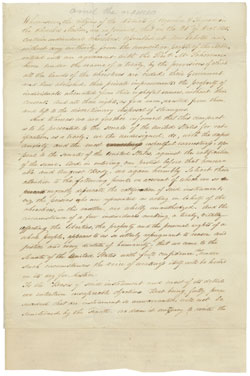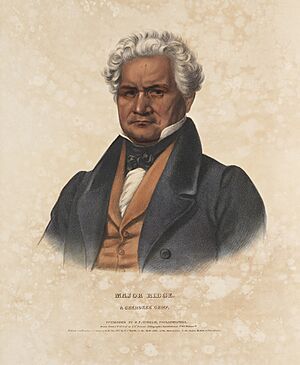Sovereignty (play) facts for kids
Sovereignty is a play written by Mary Kathryn Nagle, an American lawyer and writer. The story is about Sarah Ridge Polson, a Cherokee lawyer. She fights to bring back the Cherokee Nation's right to govern itself. Sarah also deals with the past struggles of her ancestors. They signed an important treaty that caused the Cherokee people to be moved from their homes.
Contents
About the Play's First Show
The play Sovereignty first opened on January 12, 2018. It was shown at the Kreeger Theater in Washington D.C. The show ran until February 18, 2018. Molly Smith, an American director, led the first production. A book version of the play will be printed by Northwestern University Press in 2020.
Who Was in the Original Cast?
- Joseph Carlson: Andrew Jackson / Ben
- Kyla García: Sarah Polson
- Michael Glenn: Samuel Worcester / Mitch
- Jake Hart: Elias Boudinot / Watie
- Kalani Queypo: John Ridge
- Andrew Roa: Major Ridge / Rodger Ridge Polson
- Dorea Schmidt: Sarah Bird Northrup / Flora Ridge / Offstage Woman's Voice
- Todd Scofield: White Chorus Man
- Jake Waid: John Ross / Jim Ross
Understanding the Play's History
Sovereignty tells two stories at once. One story happens in the 1830s. The other takes place in America today. The modern story follows Sarah Polson. She returns to the Cherokee Nation to help Native American women. She uses a law called the Violence Against Women Act.
Sarah Polson is a descendant of the Ridge family. This family is known for signing the Treaty of New Echota. This treaty gave Cherokee land to the United States. This land was in the state of Georgia. The treaty led to the forced movement of the Cherokee people to Oklahoma. This sad journey is known as the Trail of Tears. Sarah's family members are buried in a cemetery on the Oklahoma reservation.
The Treaty of New Echota was signed on December 29, 1835. This agreement gave all Cherokee lands east of the Mississippi River to the United States. It also promised the Nation a chance to expand west. The signing of this treaty caused a lot of disagreement within the Cherokee Nation. Some people supported it, while others strongly opposed it.
Major Ridge and his son, John Ridge, were part of the "Treaty Party." This group of Cherokees believed that moving from their land was unavoidable. They thought it was best to negotiate and cooperate. Other Cherokee members were very much against signing the treaty. They did not want to leave their homes. This big disagreement is a key part of Sarah Polson's family story in the play. Because of the conflict over the treaty, Cherokee tribesmen attacked Major and John Ridge in 1839. This was done as a form of political revenge.
Key Historical Figures in the Play
John Ridge's Story
John Ridge, also called Skah-tle-loh-skee, came from an important family in the Cherokee Nation. He was part of the "Treaty Party." He believed that Native Americans would soon be forced to move. So, he supported making a treaty with the United States. This treaty would protect Cherokee rights. He and others in his group were opposed by Principal Chief John Ross. After the treaty was signed in 1836, the Ridge family moved to the Indian Territory (now Oklahoma). This was two years before most Cherokees were forced to move. On June 22, 1839, Cherokees who supported John Ross attacked the treaty signers. John Ridge was hurt in front of his wife and children.
Major Ridge's Story
Major Ridge, John Ridge's father, also played a part in signing the Treaty of New Echota. He grew up as a traditional hunter and warrior. He fought against Americans taking over Cherokee land. Later, he helped create a three-part Cherokee government in 1827. He served as a counselor alongside his friend, John Ross. When he chose to support the treaty, he and Ross disagreed strongly. Each took a different side in the conflict. Major also moved to the Indian Territory with John Ridge and their family after the treaty was completed. On June 22, 1839, Major was killed for signing the treaty. This happened while he was on his way to his farm in the Indian Territory.
John Ross's Story
John Ross was the Principal Chief of the Cherokee Nation from 1828 to 1866. He was close with the Ridges before the treaty. Under his leadership, and working with Major Ridge, he helped the Cherokees change their economy. They moved from hunting to farming. They started farms and owned slaves. The Cherokee Nation began to split when Ross refused to sign the treaty. This led to his arrest without any charges. While he was held, Major Ridge and the Treaty Party signed the Treaty of New Echota. This gave their lands to the United States.
About the Playwright
Mary Kathryn Nagle studied at Georgetown University. She later earned her law degree from Tulane Law School. She is now the leader of Yale's Indigenous Performing Arts Program. She is also a lawyer and partner at Pipesterm Law firm. She works to protect the rights and freedoms of Native Americans and their Nations.
Nagle has said that her law background showed her how harmful stories were made about Native Americans in American law and society. She said that fighting for her people's rights made her realize something important. For things to change, people need to know the true stories of Native American peoples and their experiences. This is why theater helps her spread awareness about Native American issues.
Main Ideas in the Play
What Does "Sovereignty" Mean?
The play's title, "sovereignty," has a deeper meaning. It connects to bigger ideas about the term for Native American causes. One meaning in the play is about Native Americans taking back their voice. This means telling their own history in their own way. The play shows this by telling a story through performance. This keeps alive the tradition of oral history. The idea of taking back their historical voice is also shown in the play's casting. All Native American characters are played by actors of Native American descent.
How the Past Affects the Present
The play moves between the past and the present. This shows how historical events still impact today. Showing descendants of important Native American figures also highlights how ancestors and current generations connect. This shapes actions in the past, present, and future. The past affecting the present can also explain challenges faced by Native Americans today. For example, Native Americans in the United States are more likely to experience stress from past events. Their life expectancy is also lower than the general U.S. population. They also have a higher chance of living in poverty.
Healing and Forgiveness
The play talks about sovereignty and belonging. But it also discusses moving forward. This idea comes to light with how the past affects the present. Kyla Garcia, an actress in the play, says that Native American and white people must face the past. This allows one group to begin healing. It helps the other group understand forgiveness. Starting this process, she believes, would help everyone create a better future. It means not avoiding, ignoring, or rewriting history. The actress also points to Germany's actions to remember its past mistakes during the Holocaust. This is an example of being aware of harm done and working toward healing and forgiveness.



